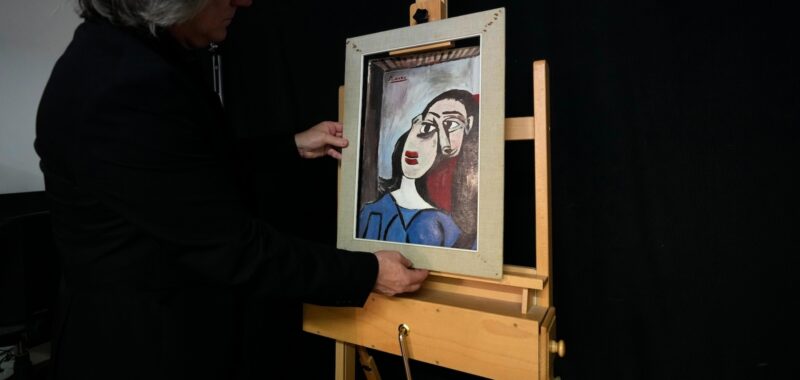MILAN — An Italian family hopes to prove definitively that a painting discarded from a villa on the island of Capri more than 60 years ago is a Picasso, and has been gathering scientific data to persuade Picasso’s estate administration in Paris to make the definitive call.
The rolled-up canvas of a female figure was discovered in a pile of trash that a junk dealer was hired to discard in the early 1960s, and it hung innocuously in the family living room and then restaurant in Pompei, near Naples, for years until his son decided to investigate.
“My mother called it ugly,” the junk dealer’s son, Andrea Lo Russo, said Thursday. “Here, we are used to landscapes featuring the sea.”
Lo Russo said that his first inkling that the painting may be an important work came when he saw a Picasso in a middle school textbook, but neither his teacher nor his father were persuaded. His curiosity persisted, and in his early 20s, he and his brother drove to Paris and brought the painting to the Picasso Museum.
“They looked, and they said, ‘It is not possible,’” Lo Russo recalled. He said that he declined their invitation to leave the painting for further examination, not wanting to relinquish it.
Over the years, Lo Russo said that his attempts to verify the painting exposed him to fraudsters who tricked him out of money, and even landed him under investigation for suspicion of trafficking in forged art — which was dropped after he produced paperwork showing his attempts to verify the painting’s origin.
After decades of trying to determine the painting’s provenance, Lo Russo believes that a recent battery of tests carried out by the Swiss-based Arcadia Foundation finally offers proof that it’s the work of Picasso.
They include lab tests that show the paints used were consistent with Picasso’s color palette during the period in question, said Luca Marcante, a trained chemist who founded the Arcadia Foundation in 2000 to investigate the provenance of artworks. Most recently, a handwriting expert authenticated the signature on the upper-left hand corner as that of Picasso, Marcante said.
The only entity that can authenticate the painting is the Picasso Administration in Paris. It hasn’t responded to a series of inquires over the years. Marcante said that he’s preparing to share the most recent findings with them.
“You need to understand, they get dozens of inquiries every day from private people believing they have found a Picasso,’’ Marcante said.
Contacted by The Associated Press, the Picasso Administration declined to comment on the case.
Marcante put the value of the painting at 6 million euros ($6.6 million), but said that if fully authenticated, it would soar to 10-12 million euros. After years of hanging casually in the Lo Rosso family home, it’s now in a vault in Milan.
Marcante said that the painting is strikingly similar to a 1949 painting attributed to Picasso called “Tete du femme,’’ which is included in the online Picasso Project curated by the Sam Houston State University in Texas.
Marcante said that there is photographic proof Picasso visited the ruins of Pompeii in 1917, and asserts that he likely also visited nearby Capri, where he may have painted the Lo Russo-owned canvas sometime in the early 1940s, leaving it behind “forgotten in time.”
Marcante is convinced that the found painting isn’t a forgery, because of the differences between the two, including different ceilings, and a missing edge on the seat.
The painting “Tete du femme,” appears to be of Picasso’s one-time lover Dora Maar, given the dark hair and dark eyes, according to Enrique Mallen, the Picasso scholar who runs the online project. He cast doubt on the theory that Picasso would have created two paintings that were so similar.
“From what I know of studying Picasso for 30 years, he would never do an identical copy of his own work,’’ Mallen told The Associated Press. “He was quoted as saying, ‘You can copy anyone expect yourself.’”
The only record of “Tete du femme” was in a 1967 book, where it was listed as being in a private collection in Turin. It has never turned up in other references, Mallen said.
Mallen underlined that his online database, which numbers more than 41,000 Picasso entries, assembles images of paintings, sculptures, drawings and other works attributed to the artist, but doesn’t attest to their authentication — something only the Picasso Administration can do.
Marcante called the “Tete du femme” “a ghost painting, because no one has ever seen it.”
“The only real one is ours, that we have examined in a scientific manner. We are convinced of our work, and of the results science has given us,” Marcante said. “We can touch this painting with our hands. It is real, it is authentic.”
If the painting his father discovered is confirmed to be a Picasso, Lo Russo said that the family is still trying to figure out if they would sell it, caught in a whirlwind of inquiries since news of the painting’s suspected provenance surfaced this week.
“We are confused ourselves,” he said.

